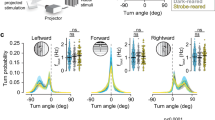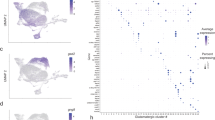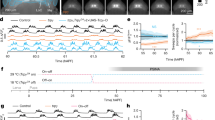Abstract
Much of the information processing in the brain occurs at the level of local circuits; however, the mechanisms underlying their initial development are poorly understood. We sought to examine the early development and plasticity of local excitatory circuits in the optic tectum of Xenopus laevis tadpoles. We found that retinal input recruits persistent, recurrent intratectal synaptic excitation that becomes more temporally compact and less variable over development, thus increasing the temporal coherence and precision of tectal cell spiking. We also saw that patterned retinal input can sculpt recurrent activity according to a spike timing–dependent plasticity rule, and that impairing this plasticity during development results in abnormal refinement of the temporal characteristics of recurrent circuits. This plasticity is a previously unknown mechanism by which patterned retinal activity allows intratectal circuitry to self-organize, optimizing the temporal response properties of the tectal network, and provides a substrate for rapid modulation of tectal neuron receptive-field properties.
This is a preview of subscription content, access via your institution
Access options
Subscribe to this journal
Receive 12 print issues and online access
$209.00 per year
only $17.42 per issue
Buy this article
- Purchase on Springer Link
- Instant access to full article PDF
Prices may be subject to local taxes which are calculated during checkout







Similar content being viewed by others
References
Peters, A. & Payne, B.R. Numerical relationships between geniculocortical afferents and pyramidal cell modules in cat primary visual cortex. Cereb. Cortex 3, 69–78 (1993).
Haider, B., Duque, A., Hasenstaub, A.R. & McCormick, D.A. Neocortical network activity in vivo is generated through a dynamic balance of excitation and inhibition. J. Neurosci. 26, 4535–4545 (2006).
Saito, Y. & Isa, T. Local excitatory network and NMDA receptor activation generate a synchronous and bursting command from the superior colliculus. J. Neurosci. 23, 5854–5864 (2003).
Reinagel, P., Godwin, D., Sherman, S.M. & Koch, C. Encoding of visual information by LGN bursts. J. Neurophysiol. 81, 2558–2569 (1999).
Somers, D.C., Nelson, S.B. & Sur, M. An emergent model of orientation selectivity in cat visual cortical simple cells. J. Neurosci. 15, 5448–5465 (1995).
Lisman, J.E. & Idiart, M.A. Storage of 7 ± 2 short-term memories in oscillatory subcycles. Science 267, 1512–1515 (1995).
Sutula, T.P. & Dudek, F.E. Unmasking recurrent excitation generated by mossy fiber sprouting in the epileptic dentate gyrus: an emergent property of a complex system. Prog. Brain Res. 163, 541–563 (2007).
McCormick, D.A., Trent, F. & Ramoa, A.S. Postnatal development of synchronized network oscillations in the ferret dorsal lateral geniculate and perigeniculate nuclei. J. Neurosci. 15, 5739–5752 (1995).
Buonomano, D.V. Timing of neural responses in cortical organotypic slices. Proc. Natl. Acad. Sci. USA 100, 4897–4902 (2003).
Beggs, J.M. & Plenz, D. Neuronal avalanches are diverse and precise activity patterns that are stable for many hours in cortical slice cultures. J. Neurosci. 24, 5216–5229 (2004).
Ikegaya, Y. et al. Synfire chains and cortical songs: temporal modules of cortical activity. Science 304, 559–564 (2004).
Sur, M. & Leamey, C.A. Development and plasticity of cortical areas and networks. Nat. Rev. Neurosci. 2, 251–262 (2001).
Debski, E.A. & Cline, H.T. Activity-dependent mapping in the retinotectal projection. Curr. Opin. Neurobiol. 12, 93–99 (2002).
Holt, C.E. & Harris, W.A. Order in the initial retinotectal map in Xenopus: a new technique for labeling growing nerve fibres. Nature 301, 150–152 (1983).
Tao, H.W. & Poo, M.M. Activity-dependent matching of excitatory and inhibitory inputs during refinement of visual receptive fields. Neuron 45, 829–836 (2005).
Lazar, G. The development of the optic tectum in Xenopus laevis: a Golgi study. J. Anat. 116, 347–355 (1973).
Lazar, G. & Szekely, G. Golgi studies on the optic center of the frog. J. Hirnforsch. 9, 329–344 (1967).
Nakagawa, H., Miyazaki, H. & Matsumoto, N. Principal neuronal organization in the frog optic tectum revealed by a current source density analysis. Vis. Neurosci. 14, 263–275 (1997).
Grusser, O. & Grusser-Cornhels, U. Neurophysiology of the anuran visual system. in Frog Neurobiology: a Handbook (eds. Llinás, R. & Precht, W.) 297–385 (Springer-Verlag, Berlin, New York, 1976).
Lee, P.H., Helms, M.C., Augustine, G.J. & Hall, W.C. Role of intrinsic synaptic circuitry in collicular sensorimotor integration. Proc. Natl. Acad. Sci. USA 94, 13299–13304 (1997).
Sparks, D.L. Translation of sensory signals into commands for control of saccadic eye movements: role of primate superior colliculus. Physiol. Rev. 66, 118–171 (1986).
Cline, H.T., Wu, G.Y. & Malinow, R. In vivo development of neuronal structure and function. Cold Spring Harb. Symp. Quant. Biol. 61, 95–104 (1996).
Akerman, C.J. & Cline, H.T. Depolarizing GABAergic conductances regulate the balance of excitation to inhibition in the developing retinotectal circuit in vivo. J. Neurosci. 26, 5117–5130 (2006).
Pratt, K.G. & Aizenman, C.D. Homeostatic regulation of intrinsic excitability and synaptic transmission in a developing visual circuit. J. Neurosci. 27, 8268–8277 (2007).
Wu, G., Malinow, R. & Cline, H.T. Maturation of a central glutamatergic synapse. Science 274, 972–976 (1996).
Lau, P.M. & Bi, G.Q. Synaptic mechanisms of persistent reverberatory activity in neuronal networks. Proc. Natl. Acad. Sci. USA 102, 10333–10338 (2005).
Xu-Friedman, M.A. & Regehr, W.G. Probing fundamental aspects of synaptic transmission with strontium. J. Neurosci. 20, 4414–4422 (2000).
Aizenman, C.D. & Cline, H.T. Enhanced visual activity in vivo forms nascent synapses in the developing retinotectal projection. J. Neurophysiol. 97, 2949–2957 (2007).
Celikel, T., Szostak, V.A. & Feldman, D.E. Modulation of spike timing by sensory deprivation during induction of cortical map plasticity. Nat. Neurosci. 7, 534–541 (2004).
Mu, Y. & Poo, M.M. Spike timing–dependent LTP/LTD mediates visual experience-dependent plasticity in a developing retinotectal system. Neuron 50, 115–125 (2006).
Vislay-Meltzer, R.L., Kampff, A.R. & Engert, F. Spatiotemporal specificity of neuronal activity directs the modification of receptive fields in the developing retinotectal system. Neuron 50, 101–114 (2006).
Aizenman, C.D., Munoz-Elias, G. & Cline, H.T. Visually driven modulation of glutamatergic synaptic transmission is mediated by the regulation of intracellular polyamines. Neuron 34, 623–634 (2002).
Zhang, L.I., Tao, H.W., Holt, C.E., Harris, W.A. & Poo, M. A critical window for cooperation and competition among developing retinotectal synapses. Nature 395, 37–44 (1998).
Lamsa, K.P., Heeroma, J.H., Somogyi, P., Rusakov, D.A. & Kullmann, D.M. Anti-Hebbian long-term potentiation in the hippocampal feedback inhibitory circuit. Science 315, 1262–1266 (2007).
Rajan, I. & Cline, H.T. Glutamate receptor activity is required for normal development of tectal cell dendrites in vivo. J. Neurosci. 18, 7836–7846 (1998).
Aizenman, C.D., Akerman, C.J., Jensen, K.R. & Cline, H.T. Visually driven regulation of intrinsic neuronal excitability improves stimulus detection in vivo. Neuron 39, 831–842 (2003).
Ruthazer, E.S., Akerman, C.J. & Cline, H.T. Control of axon branch dynamics by correlated activity in vivo. Science 301, 66–70 (2003).
Grewer, C. & Hess, G.P. On the mechanism of inhibition of the nicotinic acetylcholine receptor by the anticonvulsant MK-801 investigated by laser-pulse photolysis in the microsecond-to-millisecond time region. Biochemistry 38, 7837–7846 (1999).
Jayaraman, V., Usherwood, P.N. & Hess, G.P. Inhibition of nicotinic acetylcholine receptor by philanthotoxin-343: kinetic investigations in the microsecond time region using a laser-pulse photolysis technique. Biochemistry 38, 11406–11414 (1999).
Edwards, J.A. & Cline, H.T. Light-induced calcium influx into retinal axons is regulated by presynaptic nicotinic acetylcholine receptor activity in vivo. J. Neurophysiol. 81, 895–907 (1999).
Lopez, J.M., Smeets, W.J. & Gonzalez, A. Choline acetyltransferase immunoreactivity in the developing brain of Xenopus laevis. J. Comp. Neurol. 453, 418–434 (2002).
Udin, S.B. & Fisher, M.D. The development of the nucleus isthmi in Xenopus laevis. I. Cell genesis and the formation of connections with the tectum. J. Comp. Neurol. 232, 25–35 (1985).
Carandini, M. Amplification of trial-to-trial response variability by neurons in visual cortex. PLoS Biol. 2, E264 (2004).
Priebe, N.J., Mechler, F., Carandini, M. & Ferster, D. The contribution of spike threshold to the dichotomy of cortical simple and complex cells. Nat. Neurosci. 7, 1113–1122 (2004).
Fu, Y.X. et al. Temporal specificity in the cortical plasticity of visual space representation. Science 296, 1999–2003 (2002).
Yao, H., Shi, L., Han, F., Gao, H. & Dan, Y. Rapid learning in cortical coding of visual scenes. Nat. Neurosci. 10, 772–778 (2007).
Cassenaer, S. & Laurent, G. Hebbian STDP in mushroom bodies facilitates the synchronous flow of olfactory information in locusts. Nature 448, 709–713 (2007).
Nieuwkoop, P.D. & Faber, J. Normal Table of Xenopus laevis (Daudin) (Garland Publishing, New York, 1956).
Clements, J.D. & Bekkers, J.M. Detection of spontaneous synaptic events with an optimally scaled template. Biophys. J. 73, 220–229 (1997).
Acknowledgements
We thank I. Sears for technical support and D. Berson, M. Mehta, E. Bienenstock and members of the Aizenman lab for helpful discussion. K.G.P. is supported by an National Research Service Award from the US National Eye Institute, and C.D.A. is supported by a generous gift from the Klingenstein Foundation and the American Heart Association.
Author information
Authors and Affiliations
Contributions
K.G.P., W.D. and C.D.A. all contributed to the experimental design, electrophysiology experiments, data analysis and preparation of the figures. K.G.P. and C.D.A. also prepared the manuscript.
Corresponding author
Supplementary information
Supplementary Text and Figures
Supplementary Figures 1–3 and Methods (PDF 280 kb)
Rights and permissions
About this article
Cite this article
Pratt, K., Dong, W. & Aizenman, C. Development and spike timing–dependent plasticity of recurrent excitation in the Xenopus optic tectum. Nat Neurosci 11, 467–475 (2008). https://doi.org/10.1038/nn2076
Received:
Accepted:
Published:
Issue Date:
DOI: https://doi.org/10.1038/nn2076
This article is cited by
-
Fragile X mental retardation protein knockdown in the developing Xenopus tadpole optic tectum results in enhanced feedforward inhibition and behavioral deficits
Neural Development (2016)
-
Color and intensity discrimination in Xenopus laevis tadpoles
Animal Cognition (2016)
-
Global Hyper-synchronous Spontaneous Activity in the Developing Optic Tectum
Scientific Reports (2013)
-
Sensory modality–specific homeostatic plasticity in the developing optic tectum
Nature Neuroscience (2011)
-
Neurodevelopmental effects of chronic exposure to elevated levels of pro-inflammatory cytokines in a developing visual system
Neural Development (2010)



